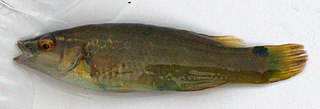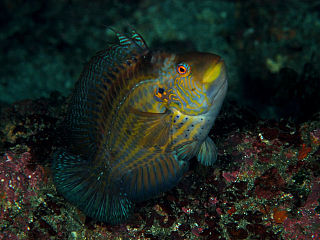
The wrasses are a family, Labridae, of marine fish, many of which are brightly colored. The family is large and diverse, with over 600 species in 81 genera, which are divided into 9 subgroups or tribes. They are typically small fish, most of them less than 20 cm (7.9 in) long, although the largest, the humphead wrasse, can measure up to 2.5 m (8.2 ft). They are efficient carnivores, feeding on a wide range of small invertebrates. Many smaller wrasses follow the feeding trails of larger fish, picking up invertebrates disturbed by their passing. Juveniles of some representatives of the genera Bodianus, Epibulus, Cirrhilabrus, Oxycheilinus, and Paracheilinus hide among the tentacles of the free-living mushroom corals & Heliofungia actiniformis.

Coris is a genus of wrasses, collectively known as the rainbow wrasses, found in the Atlantic, Indian, and Pacific Oceans.

Notolabrus is a genus of wrasses native to the eastern Indian Ocean and the southwestern Pacific Ocean from Australia to New Zealand.

Pseudojuloides is a genus of wrasses native to the Indian and Pacific Oceans.

The bluestreak cleaner wrasse, Labroides dimidiatus, is one of several species of cleaner wrasses found on coral reefs from Eastern Africa and the Red Sea to French Polynesia. Like other cleaner wrasses, it eats parasites and dead tissue off larger fishes' skin in a mutualistic relationship that provides food and protection for the wrasse, and considerable health benefits for the other fishes.

The goldsinny wrasse is a species of ray-finned fish, a wrasse from the family Labridae which is native to the eastern Atlantic Ocean and associated seas. This species is the only known member of its genus.

Paracheilinus is a genus of flasher wrasses, native to the Indian Ocean and the western Pacific Ocean.

Decodon verticillatus, the sole species in the genus Decodon, is a flowering plant in the family Lythraceae. It is commonly known as waterwillow or swamp loosestrife. It is native to wetlands in the eastern half of the United States and Canada.

The creole wrasse is a species of wrasse native to the western Atlantic Ocean.

Epibulus is a genus of wrasses native to the Indian Ocean and the western Pacific Ocean.

Hologymnosus is a genus of wrasses native to the Indian Ocean and the western Pacific Ocean.
Leptojulis is a genus of wrasses native to the Indian Ocean and the western Pacific Ocean.

The seagrass wrasse, Novaculoides macrolepidotus, is a species of wrasse native to the Indian Ocean and the western Pacific Ocean. It can be found in lagoons and mangrove forests in seagrass beds or on sandy areas with plentiful algal growth. It occurs at depths from the surface to 10 m (33 ft). This species grows to 16 cm (6.3 in) in total length. It can be found in the aquarium trade. This species is the only known member of its genus. The juveniles and smaller adults of this species are Batesian mimics of the venomous waspfish in the genus Ablabys. When threatened, these fish dive headfirst into the sea grass or sea weed beds they inhabit.
The pelvic-spot wrasse, also known as the midget wrasse or pink-streaked wrasse, is a species of wrasse native to tropical waters of the western Pacific Ocean. It can be found on coral reefs in areas with little wave action at depths from 5 to 15 m. This species grows to 6.5 cm (2.6 in) in total length. Pseudocheilinops ataenia is the only known member of its genus.

Pseudocoris is a genus of wrasses native to the eastern Indian Ocean and the western Pacific Ocean.

The chiseltooth wrasse is a species of marine ray-finned fish, a wrasse from the family Labridae. It is native to the Indian Ocean and the western Pacific Ocean. It is an inhabitant of coral reefs and can be found at depths from 3 to 60 m, though rarely deeper than 40 m (130 ft). This species grows to 30 cm (12 in) in total length. It is of minor importance to local commercial fisheries and can be found in the aquarium trade. P. moluccanus is the only known member of its genus.

Pteragogus is a genus of wrasses native to the Indian Ocean and the western Pacific Ocean.
The finspot wrasse, also known as the pinkspeckled wrasse, pearly rainbowfish or pearly weed wrasse, is a species of wrasse native to the western Pacific Ocean. It can be found on coral reefs at depths from 2 to 10 m. This species grows to 10 centimetres (3.9 in) in standard length. It can also be found in the aquarium trade. This species is the only known member of its genus.
The blue-banded wrasse is a species of wrasse native to the easternmost Indian Ocean and the western Pacific Ocean. It is an inhabitant of reefs, preferring substrates of flat sand or rubble at depths of from 15 to 85 m. This species grows to 12 cm (4.7 in) in standard length. It is of minor importance to local commercial fisheries. This species is the only known member of its genus.

Decodon puellaris, the red hogfish, is a species of marine ray-finned fish from the family Labridae, the wrasses, from the western Atlantic Ocean.
















